Part 73: Scenario Editor: The Race to Rangoon
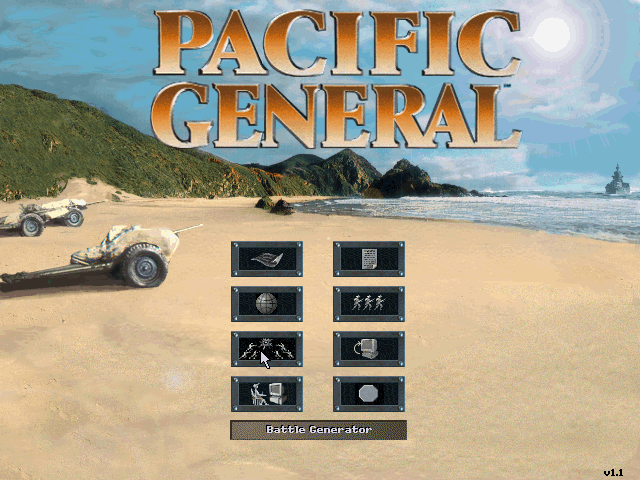
For this final update we're going to take a look at one last component of the game -- the scenario editor.
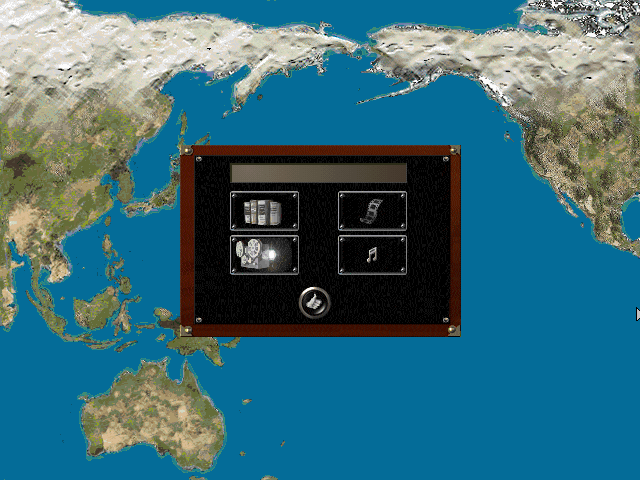
Actually, I want to mention very briefly the Information section. It lets you access the opening cinematic, the music, and, on those bookshelves, the game's encyclopedia.

Every unit in the game has an entry here (though some essentially say nothing), although this oddly doesn't give their stats, just the information.

Although there are an impressive number of countries represented, some get thrown into a catch-all category, like 'Latin America' getting a Panamanian flag. Still, there is indeed a Peruvian submarine in this game.
Here we see one more sign of the game's potential. Clearly with all of this detail there were plans to make this something more than what it ended up being. Those short campaigns barely cover the war, but the building blocks are there to take this to many more theaters.

Which brings us to the only way it's possible to do so, the Battle Generator.
On this screen you can customize the set-up of the battle, from date, climate and countries to the victory conditions.
I'm going to be creating a scenario for Burma, but in 1945, with the Allies finally on the move and poised to liberate the territory.
At the end of 1944, Japan's last offensive had exhausted itself. The British were now finally strong enough to push back. With no reinforcements coming for the Japanese, their only hope was to keep the British from defeating them too quickly, and maybe foil their plans to wrap things up in Asia. The British offensive Operation Capital forced a rapid retreat of the Japanese. The early success led to Operation Extended Capital, which had the goal of taking Rangoon before the summer monsoon season. It succeeded just in time, with Rangoon being taken and the Japanese effectively removed from the fight by early May.
Historically, it wasn't that large of a battle, and not terribly decisive, but it required a very rapid advance in an unforgiving territory, with a few key cities that needed to be dealt with. That makes a pretty good fit for a Panzer General battle.
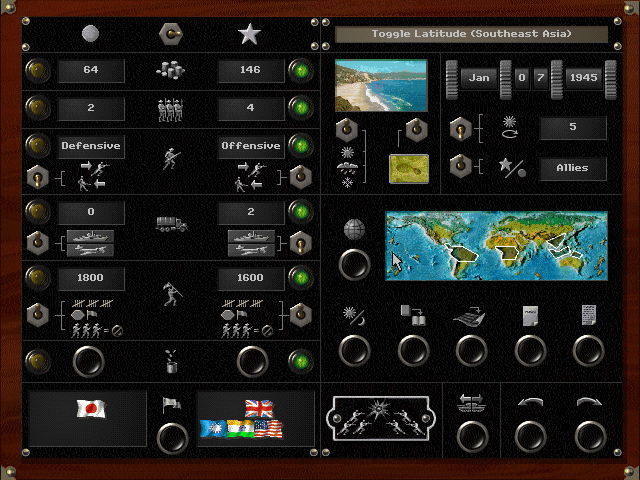
Here are the settings. The start date will be January 7, 1945, and with 5 days per turn, 24 turns will put us right at the start of May for the last turn. We set the climate to 'Southeast Asia', which should handle the proper weather. The Allies are on the offensive. Note that you can't have neutral/third party players in custom scenarios.

We also have to choose our map from this screen. Unfortunately the editor does not allow you to create a map, so you're stuck with what they already made. But there are a few maps from other locations that would allow for a few battles with the European belligerents (e.g. Cobra, Berlin, and El Alamein). While looking back at this I noticed that there are more than are listed here, as there's also a map for Olympic, suggesting that the campaign might have been intended to last longer. (Operation Olympic was the planned first part of Operation Downfall; it had the aim of capturing the southern Home Islands prior to Operation Coronet).
Back on the main scenario settings, on the left we have the prestige, unit slots, and victory conditions. The victory conditions show the victory points needed to win, which will of course depend on the units/objective values. The toggle also allows for a different way to win, by requiring a number of objective hexes, roughly the way Panzer General worked, or requiring a number of units to be alive. All victory conditions are in effect, not just the toggled one. The others can be effectively ignored by setting their value appropriately.
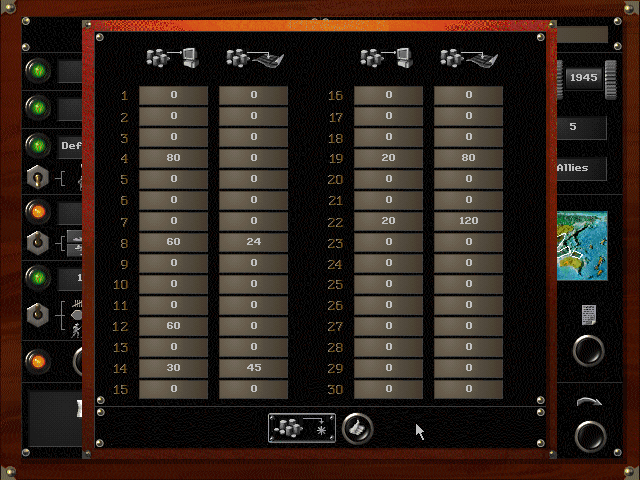
The other important thing to handle is the prestige 'bucket schedule'. This is how prestige is allotted to the sides and also provides a way to boost the AI player.
The way the bucket schedule works, according to the manual:
The left column is the 'scenario reward'; this is prestige added to the total for the side on that turn. Both human and AI players get this reward. The right column is the 'AI reward' (I think of this as the 'map reward'), intended for defensive scenarios. The amount of the AI reward is scaled by the percentage of objective hexes held, out of the total held by that side at the beginning. As far as I can tell, it's scaled by number of hexes, not their value. This allows the addition of low-value objectives to give the AI a boost for holding territory generally, even if it's not in strategic locations.
There's one quirk of the system, however. On any turn with a prestige award, the AI loses all prestige it currently has. I've no idea why this is, but it's clearly stated to happen. The AI does spend prestige as soon as it has it, so this isn't a terrible problem, but it does mean it's better to have punctuated larger rewards rather than a steady trickle. That also explains why the AI almost never purchases any quality units after the start - it can usually only afford to buy the cheapest available, and doesn't (often can't) save up.
In this battle, Japan needs to do its best to maintain what forces are there, since initially they are about even with the British (in rough quantity if not quality). A greater emphasis is placed on the map rewards as time goes on, reflecting a potential loss of morale that failing would bring for the British. The delay in rewards from turns 15 - 18 is to reflect the disruption caused by the Burmese Army when they turned against the Japanese (March 27).

The Allies get more prestige at a steady rate. They don't really need map rewards, since they're on the offensive. If I'm reading the manual correctly, the 'AI rewards' are only for objectives held at the start, and capturing objectives doesn't change this; it's meant as a performance bonus in a defensive scenario. The map rewards are there simply to give a boost to the AI player, although this isn't really intended to be played from the Axis side.
This is an engagement involving forces from several Allied countries, which can be seen from the four countries we have (UK, China, India, and the US). Even the British units included forces not only from parts of India, but Africa as well; those are in fact on the game's roster as UK units. With the nations selected, we can now start assigning units.
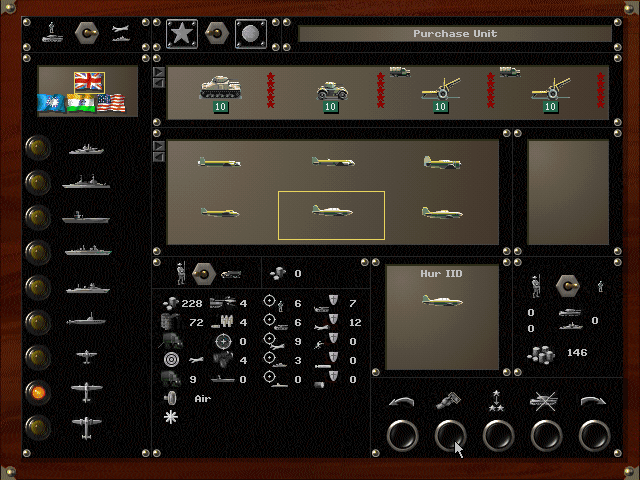
Unit selection is done via the purchase interface, just with no need to spend prestige or worry about unit slots. I believe you can designate units as core or aux, but it's meaningless in a custom battle.
This was my initial choices for each side, along with their rough deployment location :
pre:
Quantity Unit Type [Transport] Exp Loc 3 Hohei '43 - Rangoon, Yenangyaung 3 Hohei '43 * Mandalay, Lashio 2 Hohei '43 ** Monuwa, Mandalay 1 Hohei HW ** Mandalay (to E.) 1 Kihei * Mandalay (to S.) 1 INA * W. of Mandalay 1 Chi-Ha ** Meiktila 1 47mm AT - Rangoon 1 47mm AT [Isuzu] * Mandalay 1 Meiji 38 75mm - Mandalay 1 Meiji 38 75mm [Isuzu] * SW. of Mandalay 1 20mm (AD) ** Mandalay 2 20mm (AD) * Rangoon, Yenangyaung
pre:
Quantity Unit Type [Transport] Exp Loc UK 1 Kachin Raiders *** Bhamo 2 W. African Inf - Akyab 1 Inf 1944 [3Tn Lorry] * E. of Kalewa/Pyingaing 1 Engrs 1944 [3Tn Lorry] * Yeu 1 Grant ** N. of Shwebo 1 Daimler SC * Gangaw 1 P47D - Imphal 1 Hurricane IID ** Imphal China 2 Infantry 1944 - Myitson, Namkham 1 Infantry 1944 * Wanting India 2 Infantry 1944 ** Kalewa/Gangaw 1 Infantry 1944 * Kalewa 1 Infantry 1944 - N. of Shwebo 1 25-pdr Gun [3Tn Lorry] * Yeu/Shwebo 1 25-pdr Gun [3Tn Lorry] - Kalewa 2 40mm AD - Myitkina, Imphal USA 1 B-24D Liberator * Myitkina
No American ground forces are present as such. Historically the NCAC was an American unit that had been in Burma for some time in an attempt to clear the Burma Road. Here, they've been absorbed into the Chinese units they trained, and a unit of British Kachin Raiders is added to this area. Including American units would mean that capturing an objective with an American would allow the purchase of those units for the Allies. This should be a mainly British battle. Although technically there should be fewer British units as well, the game's unit roster doesn't allow the Indian forces to have tanks aside from very outdated models. This does mean that the British side could purchase or upgrade to units that historically only saw action in Europe, but I find that to be a more reasonable allowance.
On the Japanese side, the Burmese Independence Army is omitted. For one, they don't seem to have been a sizable front-line force in 1945, but more importantly, they revolted in March of 1945, resulting in chaos among some Japanese units they suddenly turned on. There's no real way to implement this switch in-game, as interesting as it could have been. The Indian National Army does get represented; it had been largely reduced in the battle for Imphal, however, so only one unit is included.
The Japanese did have some tanks, though I haven't found a good source on what they would have been. Chi-Ha's with experience seems a decent enough choice. Their AT guns were fairly minimal, as was their artillery in general. They've still been given some to allow the side a few defensive options. Their units could be a bit weaker, but I wanted a more even challenge. The game does allow for units to start at less than 10 strength, which could be interesting to play with but I think it would be odd to have in.
Air Power:
Japanese air power was nearly gone at this time. Actually giving them fighters is an option, but there'd be a need for proper fighters on the Allied side, and it'd be hard to balance. As a slight compensation, the Allied bombers are not too strong. The Hurricane was chosen as it provides better scouting range. Here's where the only American unit comes in, as a strategic bomber.

While we can't change the map or any terrain/cities on it, we can select objective hexes and re-assign them to the sides. Another thing I did is make most of the already-captured Burmese cities Indian, to discourage the purchase of British units right from the start.
Objectives:
Allied - Myitkyina[50], Imphal[50]
Losing either of these loses the battle for the Allies, but that's really unlikely to happen.
Here are the Japanese-held objectives, with the historical capture date.
Lashio[40] - 7 March
Mandalay[2x100] - 21 March
Yenangyaung[20] - 21 April
Toungoo[20] - 22 April
Rangoon Airfield[100]
Rangoon[2 x 200] - 5 May
The VP balance is such that the Allies pretty much need to get all or part of Rangoon to win. There aren't a lot of forces on either side, so the VP gain or loss is more likely to be from territory than from units destroyed.
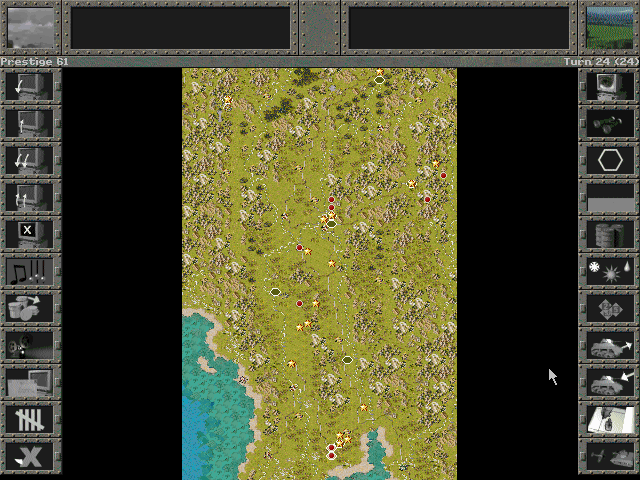
Here's the Rangoon strategic map, from a playtest of the map. One minor annoyance of the scenario editor is that you can't view this map when you're in it; all interactions are done at the regular game scale.

Here's another look at the unit placement/ map editor. Once a unit has been placed, it can be edited. This allows adjustment of experience, unit strength, and entrenchment level. Units can also be renamed as desired here; I didn't do any of that for this scenario as the scale is always a bit vague in this game.

However, despite the high value of the objective hexes and the defensive advantage of entrenchment, I discovered on playtesting that the AI rapidly abandons the positions. It seems to be tuned primarily to try and destroy the player's forces instead of trying to win. Either that or it determined it needed more units at some other location (e.g. Mandalay) and thus pulled from the rear forward.
To counter this I decided to add some fixed fortifications at Rangoon. Historically the city was practically free of resistance by the time the Allies reached it, but I think for the sake of gameplay a proper fight is called for. Even if the AI ends up moving anything it can to the front line, this will force the player to bring more than just a scout car to capture the place.

In fact, I only managed to get just that in my first try, leading to a draw.
If you own Pacific General and want to try this scenario out, you can download it from here:
Race to Rangoon
I believe it has to be placed in the SAVE folder (not the SCENARIO folder), and can then be loaded and played from the single-scenario screen. I actually found that it's not too bad to play it from the Japanese side either, if somewhat less exciting.
That wraps it up for this LP and the 5-star series for me. I've now covered all the theaters of World War 2, and don't plan on returning to this system for anything else. I hope you enjoyed this look at the somewhat forgotten branch of this game series. I would say the closest modern game to it is actually Order of Battle, which is clearly a successor (as opposed to Panzer Corps, whose system is a remake of PG2). OOB started with the Pacific side of things, and had the naval system in place from the start. It's a shame they didn't take the naval damage model too, but if you want a game in this tradition, that's where I'd go. Though if you want a similar LP, I'd recommend Jobbo Fett's ongoing run of Panzer Corps.
As for my next LP, I may be doing a different genre altogether first, but I do have another strategy game in the works. It's going to be either a more modern war, or from an earlier period than this was. I'll put the link in the new LP thread when it's ready. Thanks for reading!